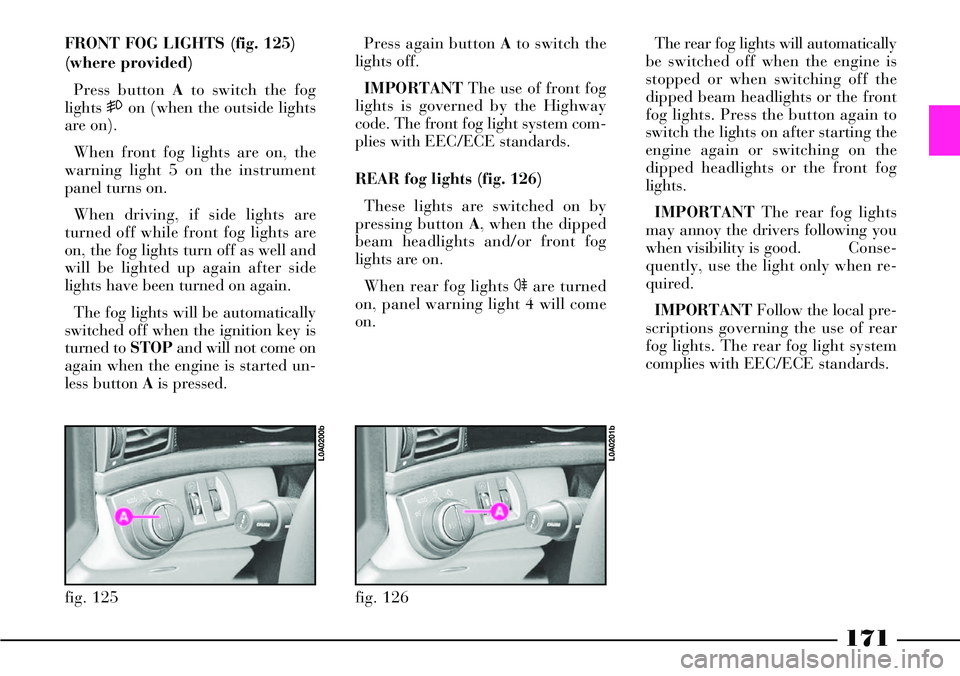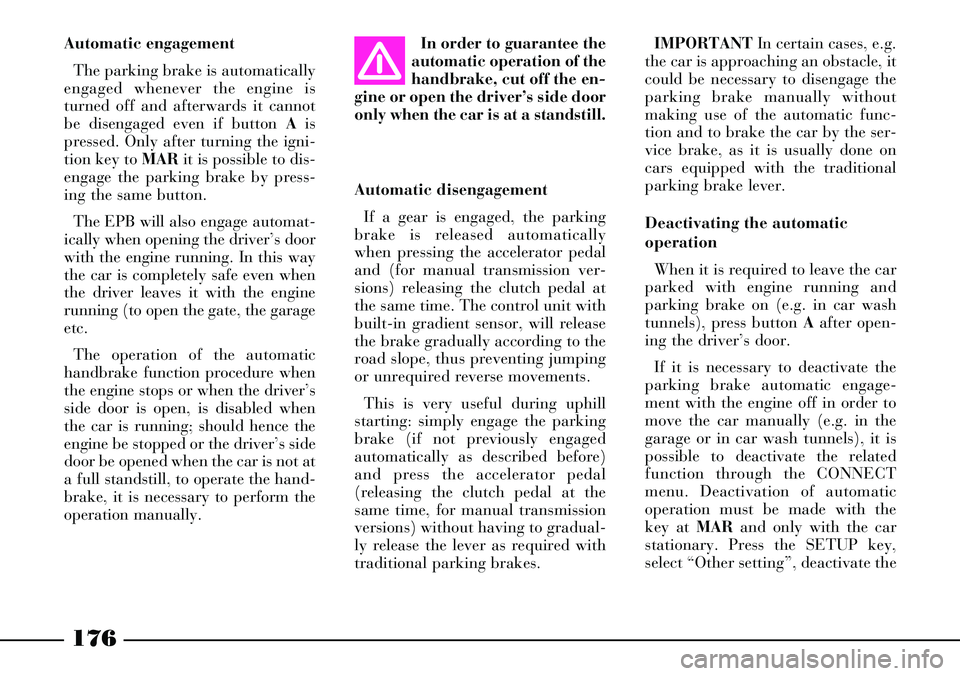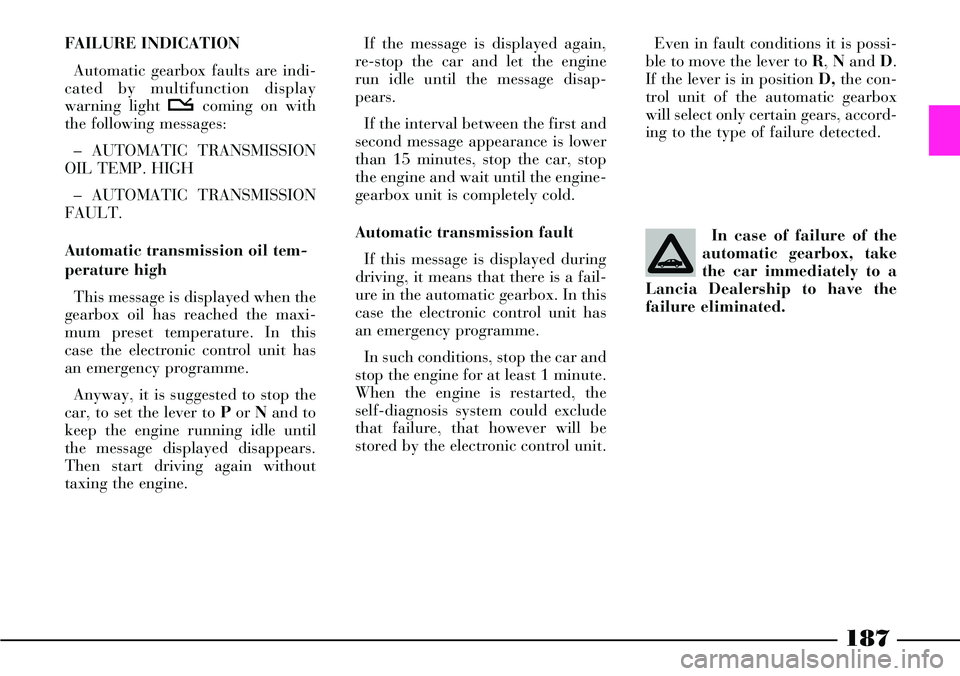stop start Lancia Thesis 2007 Owner handbook (in English)
[x] Cancel search | Manufacturer: LANCIA, Model Year: 2007, Model line: Thesis, Model: Lancia Thesis 2007Pages: 386, PDF Size: 8.69 MB
Page 167 of 386

166
– stationary: with the “programma-
ble heater” mode controlled by the
timer, the system conditions are con-
trolled by CONNECT.
The timer is automatically deacti-
vated if:
– the “programmable heater” mode
function is stopped by CONNECT if,
at the timer start, the “programmable
heater” mode is activated with the re-
mote control
– if the user manually activates the
heater during the timer operation
– if the timer is activated within 3
minutes after the previous heater
shutdown
– if the user manually deactivates
the timer– if the fuel level in the tank is low
when the timer is activated. This con-
dition is indicated with a message
coming from the system and the user
must confirm activation. If the user
does not confirm activation, the timer
is deactivated. The fuel level is indi-
cated by the CONNECT; if this infor-
mation is not available, it is taken into
consideration the last record before
stopping the engine
– if the timer is activated when the
heater operated by the remote control
is activated.
IMPORTANTIf the heater is in
prompt operating mode, the timer is
automatically stopped at the moment
of activation. Parameters set with the
timer are stored in the memory. If the
timer has been deactivated or
stopped, it should be manually reac-
tivated by the user.HEATER ACTIVATION/
DEACTIVATION WITH THE
REMOTE CONTROL (fig. 123)
Activation/deactivation of the heater
can be operated with remote control
A.
The activation signal is issued by the
remote control with a range of around
600 meters and picked up by a spe-
cific antenna placed on the car, then
it is transmitted to the supplementary
heater receiver and sent to CON-
NECT.
IMPORTANTThe maximum re-
mote control range is reached on open
land, while it is reduced in the pres-
ence of buildings.
fig. 123
L0A0263b
Page 172 of 386

171
FRONT FOG LIGHTS (fig. 125)
(where provided)
Press button Ato switch the fog
lights 5on (when the outside lights
are on).
When front fog lights are on, the
warning light 5 on the instrument
panel turns on.
When driving, if side lights are
turned off while front fog lights are
on, the fog lights turn off as well and
will be lighted up again after side
lights have been turned on again.
The fog lights will be automatically
switched off when the ignition key is
turned to STOPand will not come on
again when the engine is started un-
less button Ais pressed.Press again button Ato switch the
lights off.
IMPORTANTThe use of front fog
lights is governed by the Highway
code. The front fog light system com-
plies with EEC/ECE standards.
REAR fog lights (fig. 126)
These lights are switched on by
pressing button A, when the dipped
beam headlights and/or front fog
lights are on.
When rear fog lights 4are turned
on, panel warning light 4 will come
on.
fig. 125
L0A0200b
fig. 126
L0A0201b
The rear fog lights will automatically
be switched off when the engine is
stopped or when switching off the
dipped beam headlights or the front
fog lights. Press the button again to
switch the lights on after starting the
engine again or switching on the
dipped headlights or the front fog
lights.
IMPORTANTThe rear fog lights
may annoy the drivers following you
when visibility is good.Conse-
quently, use the light only when re-
quired.
IMPORTANTFollow the local pre-
scriptions governing the use of rear
fog lights. The rear fog light system
complies with EEC/ECE standards.
Page 176 of 386

ELECTRIC PARKING BRAKE
(EPB) (fig. 133)
The car is fitted with the EPB
(Electric Parking Brake) that cuts in
when switching the engine off and
will cut out when starting the engine
and pressing the accelerator pedal
(for manual gearbox versions when
releasing the clutch pedal at the
same time). The EPB can also be
disengaged manually by pressing
button Aset on the central console
with engine running or ignition key
to MAR.
After disengaging the EPB manual-
ly, when opening the driver’s door
the EPB will re-engage automatical-
ly, press button Aagain to disengage
it.The button shape is rather large so
the brake can be engaged rapidly,
even by the passenger, in case of
emergency.
The advantages of this system, com-
pared to the usual lever, are several:
– no effort should be made to
engage and disengage the parking
brake
– the parking brake efficiency is
always at top level in any using con-
dition, contrary to the lever which
guarantees the car complete stop only
when fully lifted
– the EPB is controlled by electric
wires, therefore all problems regard-
ing transmission cables, such as
adjustments, freezing or tears, no
longer exist
– improved safety as a result of the
sophisticated electronic control sys-
tem, similar to the ABS one, prevent-
ing wheels from blocking if the park-
ing brake is engaged during driving
– improved safety when the car is
stationary and children are left
inside the car; in this case the brake
cannot be disengaged if the ignition
key is at STOPor removed– it has automatic functions that
other systems lack.
When the parking brake is engaged
and the ignition key is at MAR, the
instrument panel warning light x
turns on.
This warning light turns on when
the parking brake reaches its highest
working level, and it turns off when
the brake is disengaged and com-
pletely released. Unlike usual park-
ing brakes, whose warning light
turns on even when the lever is lift-
ed a little bit, the EPB system warn-
ing light turns on only when the car
has come to a complete stop.
When the brake is engaged, a typi-
cal noise can be heard by the driver;
the parking brake is completely
engaged or disengaged when the
operating noise stops.
fig. 133
L0A0197b
When engaging the park-
ing brake keep the brake
pedal always depressed.
175
Page 177 of 386

176
Automatic engagement
The parking brake is automatically
engaged whenever the engine is
turned off and afterwards it cannot
be disengaged even if button Ais
pressed. Only after turning the igni-
tion key to MARit is possible to dis-
engage the parking brake by press-
ing the same button.
The EPB will also engage automat-
ically when opening the driver’s door
with the engine running. In this way
the car is completely safe even when
the driver leaves it with the engine
running (to open the gate, the garage
etc.
The operation of the automatic
handbrake function procedure when
the engine stops or when the driver’s
side door is open, is disabled when
the car is running; should hence the
engine be stopped or the driver’s side
door be opened when the car is not at
a full standstill, to operate the hand-
brake, it is necessary to perform the
operation manually.Automatic disengagement
If a gear is engaged, the parking
brake is released automatically
when pressing the accelerator pedal
and (for manual transmission ver-
sions) releasing the clutch pedal at
the same time. The control unit with
built-in gradient sensor, will release
the brake gradually according to the
road slope, thus preventing jumping
or unrequired reverse movements.
This is very useful during uphill
starting: simply engage the parking
brake (if not previously engaged
automatically as described before)
and press the accelerator pedal
(releasing the clutch pedal at the
same time, for manual transmission
versions) without having to gradual-
ly release the lever as required with
traditional parking brakes.IMPORTANTIn certain cases, e.g.
the car is approaching an obstacle, it
could be necessary to disengage the
parking brake manually without
making use of the automatic func-
tion and to brake the car by the ser-
vice brake, as it is usually done on
cars equipped with the traditional
parking brake lever.
Deactivating the automatic
operation
When it is required to leave the car
parked with engine running and
parking brake on (e.g. in car wash
tunnels), press button Aafter open-
ing the driver’s door.
If it is necessary to deactivate the
parking brake automatic engage-
ment with the engine off in order to
move the car manually (e.g. in the
garage or in car wash tunnels), it is
possible to deactivate the related
function through the CONNECT
menu. Deactivation of automatic
operation must be made with the
key at MARand only with the car
stationary. Press the SETUP key,
select “Other setting”, deactivate the In order to guarantee the
automatic operation of the
handbrake, cut off the en-
gine or open the driver’s side door
only when the car is at a standstill.
Page 178 of 386

177
“Automatic parking brake” function
and the press “OK”. Deactivation of
automatic operation can be achieved
also in the following way:
– turn the key to STOP(the park-
ing brake is engaged)
– turn the key back to MAR,
depress the brake pedal and at the
same time keep button Apressed for
at least 2 seconds. Warning light x
flashes thrice to indicate the auto-
matic operation deactivation.
When the key is turned again to
STOPthe parking brake will not be
engaged. The parking brake auto-
matic operation will be automatical-
ly restored when the key is turned
again to MAR.IMPORTANTIf, after the parking
brake has been disengaged, the car
starts moving at a speed higher than
the usual manual movement, deacti-
vation of the automatic mode is
immediately cancelled and the park-
ing brake is engaged.
If, after the parking
brake has been disen-
gaged, the car starts mov-
ing at a speed higher than the
usual manual movement, deacti-
vation of the automatic mode is
immediately cancelled and the
parking brake is engaged.Proceed as follows: release the
accelerator pedal, press and keep
button A(fig. 133) pressed for the
whole manoeuvre: the system elec-
tronic control unit will come imme-
diately into action with alternate
braking on/off cycles on the rear
wheels (thus preventing wheel lock-
ing). Braking cycles are applied
alternately on right and left wheel to
guarantee roadholding, braking
continuity and to reduce braking
distance.
Wheel locking could take place
under the safety speed threshold
(lower than 10 km/h).
A buzzer will sound during the
whole manoeuvre to indicate that
the dynamic mode shall only be used
in an emergency, but this is also use-
ful to warn the driver if the parking
brake has been inadvertently
engaged by other passengers.
Use in an emergency
In particular cases (e.g. fault in the
whole hydraulic brake system, both
service and emergency brake), the
parking brake can be used to stop
the car running (“dynamic mode”).
Page 182 of 386

181
Do not tax the engine
until it has not reached
operating temperature.
STOPPING THE CAR
To stop the car press the brake
pedal, regardless of the gear lever
position.
If the brake pedal is not
pressed, when the gear
lever is to D or R and the
engine is running idle, even on a
flat ground, the car starts moving.The ignition key can be extracted
from the ignition switch only when
the gear lever is at P(Key-lock safe-
ty) and the ignition key is at STOP.
Letter Pon the instrument panel
display (fig. 138) will come on for
30 seconds, then it will go off.IMPORTANTIn case of emer-
gency (failures, flat battery, etc.), it
is possible to remove the ignition key
even if the gear lever is not at P. To
do this, turn the key to STOP, press
button A(fig. 139) and at the same
time remove the key.
fig. 138
L0A0238b
fig. 139
L0A0178b
Page 187 of 386

186
MANUAL SEQUENTIAL
OPERATION
To use the manual sequential oper-
ation move the lever to the two-posi-
tion left sector (fig. 137):
(+) = higher gear
(–) = lower gear.
Shifting to the manual sequential
sector is possible only from position
D: the gear automatically selected
when the lever is moved will remain
engaged.
It is possible to pass to the gear
manual sequential control in any
driving condition.
To engage a higher gear, move the
lever to (+) and to shift a lower gear
move the lever to (–).IMPORTANTIf gear shift gener-
ates a runaway speed rate, such gear
is cancelled by the electronic control
unit and the driver is warned by a
buzzer and by the engaged gear
flashing on the instrument panel dis-
play.
When the manual
sequential operation is
set, gears shall be shifted
manually, as for versions with the
traditional manual gearbox. Only
when the car stops the gear auto-
matically engaged is the first one.If the lever is brought back to Dthe
gearbox immediately starts to work
automatically and will be engaged
according to the type of driving
selected.
IMPORTANTThe electronic con-
trol unit is programmed to shift one
gear at a time, therefore rapid and
repeated actions do not correspond
to rapid and repeated gear engaging.
A higher or lower gear is engaged by
shifting the lever to position (+) or
(–) after the previous request has
been realized.
In case of failure of the manual
sequential system, the electronic
control unit will select the automatic
operation.
Page 188 of 386

187
Even in fault conditions it is possi-
ble to move the lever to R, Nand D.
If the lever is in position D,the con-
trol unit of the automatic gearbox
will select only certain gears, accord-
ing to the type of failure detected.
In case of failure of the
automatic gearbox, take
the car immediately to a
Lancia Dealership to have the
failure eliminated.FAILURE INDICATION
Automatic gearbox faults are indi-
cated by multifunction display
warning light tcoming on with
the following messages:
– AUTOMATIC TRANSMISSION
OIL TEMP. HIGH
– AUTOMATIC TRANSMISSION
FAULT.
Automatic transmission oil tem-
perature high
This message is displayed when the
gearbox oil has reached the maxi-
mum preset temperature. In this
case the electronic control unit has
an emergency programme.
Anyway, it is suggested to stop the
car, to set the lever to Por Nand to
keep the engine running idle until
the message displayed disappears.
Then start driving again without
taxing the engine.If the message is displayed again,
re-stop the car and let the engine
run idle until the message disap-
pears.
If the interval between the first and
second message appearance is lower
than 15 minutes, stop the car, stop
the engine and wait until the engine-
gearbox unit is completely cold.
Automatic transmission fault
If this message is displayed during
driving, it means that there is a fail-
ure in the automatic gearbox. In this
case the electronic control unit has
an emergency programme.
In such conditions, stop the car and
stop the engine for at least 1 minute.
When the engine is restarted, the
self-diagnosis system could exclude
that failure, that however will be
stored by the electronic control unit.
Page 189 of 386

188
If the failure is signalled when the
engine is started, it means that the
electronic control unit had stored it
previously, before stopping the
engine. Even in this case, go to a
Lancia Dealershipto have the
automatic gearbox checked.
When driving with auto-
matic gearbox faulty,
drive carefully consider-
ing the limited car efficiency in
terms of acceleration and speed.
In addition, when driving with
automatic gearbox faulty, the
reverse block might not be oper-
ating: for this reason it is
absolutely necessary to move the
lever to position R while the car
is moving.SOUND SIGNAL
A buzzer will sound in the follow-
ing conditions:
– for about 15 seconds when the
driver’s door is opened while the
engine is running or not and the gear
lever has a position different from P
– for about 15 seconds when the
engine is turned off and the gear
lever has a position different from P
– for about 4 seconds when the
gear lever is shifted to R(reverse)
– with the manual sequential oper-
ation on, when the selected gear is
not accepted by the electronic con-
trol unit (e.g. since it might generate
a runaway speed rate). BUMP STARTING
Never bump starting the engine (by
pushing, towing, etc.). In an emer-
gency, when the battery is flat, start
the engine with the appropriate
emergency battery according to the
instructions contained in chapter “In
an emergency”.
Page 204 of 386

multifunction display) warn the dri-
ver and invite him to resume speed
control.
IMPORTANTIf the Radar Cruise
Control is active and the speed of the
vehicle ahead falls below 30 km/h, a
sound signal with message “RADAR
CRUISE CONTROL NOT ACTI-
VATED” on the multifunction display
warn the driver to resume speed con-
trolTherefore, the Radar Cruise Control
does not ensure control when you are
driving in a queue; the driver must
therefore halt the car and start it off
after stopping in a queue, and he
must also switch on the speed control
function every time
IMPORTANT NOTES
CONCERNING THE RADAR
CRUISE CONTROL
When driving with the Radar Cruise
Control on, its regular operation could
be affected by certain situations.
The system operation could be in-
fluenced in the following cases:If the vehicle picked by the car fit-
ted with Radar Cruise Control leaves
the radar sensor detection range, the
system could no longer be able to de-
tect it and therefore it will speed up
the car or pick another vehicle run-
ning ahead (fig. 145).
If a vehicle enters the area between
the car fitted with Radar Cruise Con-
trol and the picked vehicle (fig. 146),
the system could not be able to con-
trol braking and it will therefore warn
the driver to take control of the car.
203
fig. 145
L0A0348b
fig. 146
L0A0349b